When you're trying to distinguish between Corgi breeds, it's essential to focus on specific traits that set them apart. You'll notice that Pembroke Welsh Corgis have distinct features like shorter bodies and smaller ears, while Cardigan Welsh Corgis present a more robust appearance with rounded ears and bushy tails. But it's not just about looks; their personalities also vary significantly. Understanding these nuances can make a big difference, especially if you're considering adding one to your home. What other factors should you take into account when choosing the right Corgi for your lifestyle?
Key Takeaways
- Pembroke Welsh Corgis have docked or natural bobtails, while Cardigan Welsh Corgis possess long, bushy tails.
- Pembrokes feature smaller, upright ears, whereas Cardigans have larger, rounded ears.
- Pembrokes are generally 10-12 inches tall and weigh 25-30 pounds; Cardigans are slightly larger at 10.5-12.5 inches and 30-38 pounds.
- Pembrokes are typically more social and outgoing, while Cardigans are reserved and independent.
Overview of Corgi Breeds
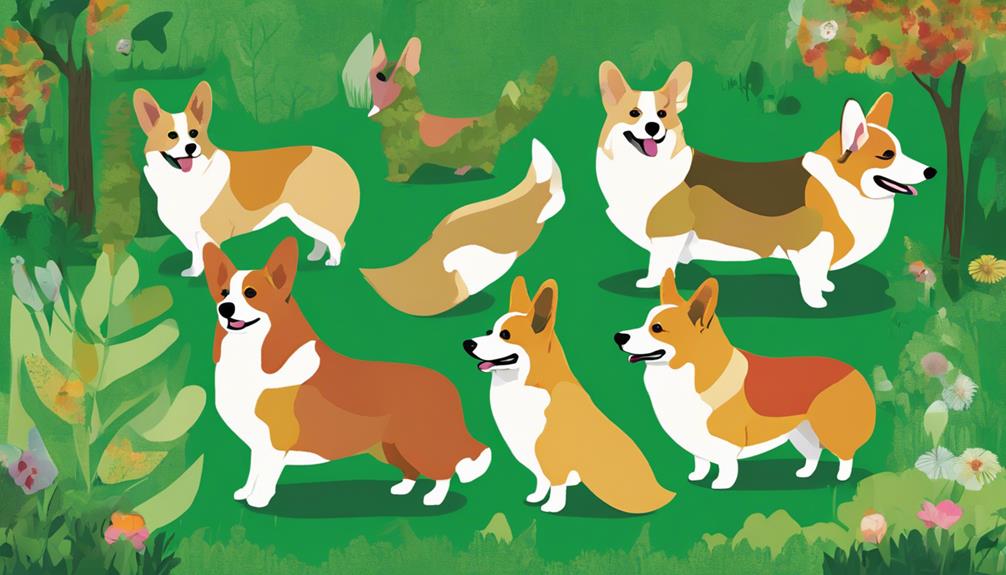
Corgis are primarily classified into two distinct breeds, the Pembroke Welsh Corgi and the Cardigan Welsh Corgi, each exhibiting unique physical traits and temperamental characteristics that reflect their historical roles and lineage. Understanding corgi history is essential for appreciating these breeds' distinctiveness.
The Pembroke Welsh Corgi, believed to have been brought to Wales by Flemish weavers in the 10th century, was primarily used as a herding dog. Its shorter tail and slightly smaller stature distinguish it from its counterpart.
On the other hand, the Cardigan Welsh Corgi boasts a lineage dating back over 3,000 years, believed to have descended from the Swedish Vallhund. This breed's origins are marked by its robust build and bushy tail, characteristics that aided in its pastoral duties.
Both breeds exhibit a strong work ethic and intelligence, traits honed through centuries of herding livestock. However, their temperaments diverge; Pembrokes tend to be more social and outgoing, whereas Cardigans often display a more reserved nature.
Understanding these breed origins will empower you to appreciate the unique qualities that each corgi brings to your life.
Physical Characteristics
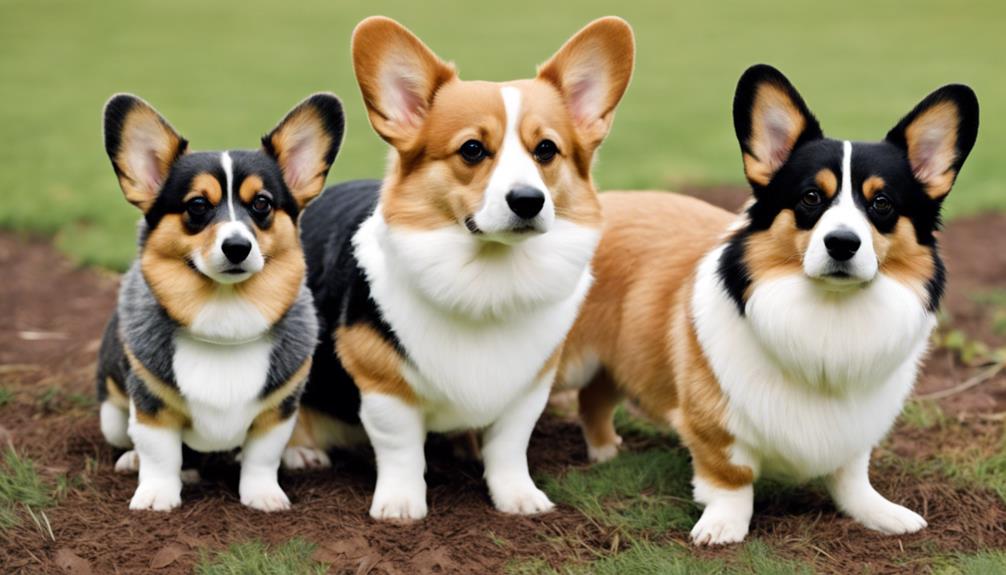
When comparing the physical characteristics of Pembroke and Cardigan Welsh Corgis, you'll notice distinct differences in tail shape and ear structure that reflect their unique breed standards. Pembrokes typically sport a docked tail or a natural bobtail, while Cardigans have a long, bushy tail that adds to their robust appearance.
In terms of ear structure, Pembrokes have a more fox-like appearance with their smaller, upright ears, while Cardigans possess larger, rounded ears that give them a more alert expression. These differences not only define each breed's aesthetic but also impact corgi grooming practices. Pembrokes may require less grooming around the tail area, while Cardigans need thorough brushing to manage their thick, double coat, especially during shedding seasons.
When choosing corgi accessories, consider these physical traits. For example, select collars that accommodate the size and strength of each breed, ensuring a comfortable fit. By understanding these specific characteristics, you'll not only appreciate the beauty of each breed but also enhance your experience in caring for your corgi, allowing them the freedom to express their unique personality.
Size Differences
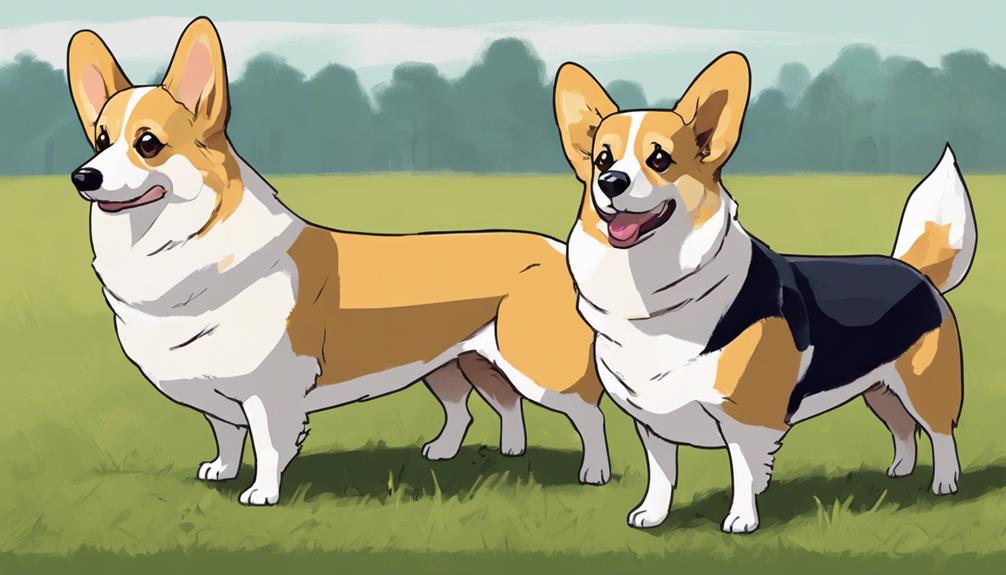
When comparing the Pembroke and Cardigan Corgis, you'll notice distinct size differences that define each breed.
The Pembroke typically stands around 10 to 12 inches at the shoulder and weighs between 25 to 30 pounds, while the Cardigan is slightly larger, measuring 10.5 to 12.5 inches tall and weighing 30 to 38 pounds.
Understanding these height and weight variations is crucial for proper breed identification and care.
Pembroke Vs. Cardigan Size
Distinguishing between Pembroke and Cardigan Corgis largely hinges on their size, with Pembrokes typically being slightly smaller and lighter than their Cardigan counterparts, which tend to have a more robust build.
In terms of Corgi breed history, the Pembroke is believed to have descended from the same lineage as the Cardigan but was refined to a more compact stature. This size difference often influences their respective personality traits, as the Pembroke, being lighter, can exhibit a more energetic demeanor, while the Cardigan, with its sturdier frame, may display a more laid-back attitude.
When considering size, you'll find that Pembrokes generally weigh between 25 to 30 pounds, while Cardigans can range from 30 to 38 pounds. Additionally, the Pembroke's shorter body length and narrower chest contribute to its agile appearance, contrasting with the Cardigan's broader chest and longer torso.
These physical characteristics not only affect their agility and stamina but also play a role in their interactions with humans and other pets. Understanding these size distinctions is crucial for potential owners seeking a Corgi that aligns with their lifestyle and preferences.
Height and Weight Variations
Height and weight variations between Pembroke and Cardigan Corgis are key indicators that can help you accurately identify each breed.
Pembrokes typically stand around 10 to 12 inches tall and weigh between 25 to 30 pounds, while Cardigans range from 10.5 to 12.5 inches in height and weigh between 30 to 38 pounds. Understanding these weight ranges and height standards is crucial for breed identification and responsible ownership.
The Pembroke's slightly shorter stature and lighter weight may appeal to those seeking a more compact companion. In contrast, the Cardigan's robust build and heavier weight can suggest a sturdier frame, making them suitable for different lifestyles. Additionally, Cardigans often have a broader chest and more muscular appearance, which can further differentiate them from their Pembroke counterparts.
When assessing your Corgi or considering adoption, keep these measurements in mind. A thorough understanding of size differences not only aids in breed recognition but also influences care considerations, such as dietary needs, exercise requirements, and health monitoring.
Coat Colors and Patterns
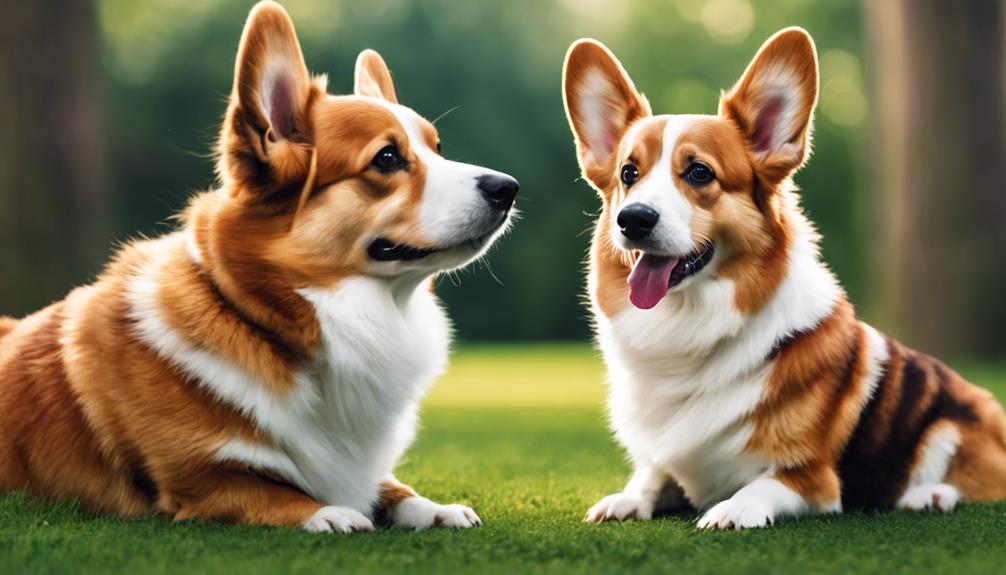
Corgis exhibit a variety of coat colors and patterns, with the most common hues including red, sable, fawn, and black and tan, each contributing to their unique breed identity.
When you explore coat genetics, you'll find that these color variations arise from specific genes influencing pigmentation. For instance, the red and sable coats are primarily influenced by the E locus, which determines the base color.
In the Pembroke Welsh Corgi, you may also notice distinct white markings, often found on the face, legs, and chest. These markings may vary in size and shape, giving each dog a distinct appearance.
The black and tan variation, more prevalent in Cardigan Welsh Corgis, showcases a darker base with rich tan accents, a trait linked to the Ay locus.
Understanding these genetic factors can help you appreciate the diversity within Corgi breeds. Whether you're drawn to the vibrant reds or the striking black and tan, recognizing the underlying coat genetics enhances your connection to these charming companions.
Ultimately, each coat color and pattern reflects the unique heritage and lineage of your Corgi, inviting you to celebrate their individuality.
Tail Variations

When examining Corgi breeds, understanding tail variations is crucial for accurate identification.
You'll notice distinct tail types, ranging from the Pembroke's docked tail to the Cardigan's long, bushy one, each influenced by genetic factors.
Additionally, regional breeding practices contribute to these differences, further complicating the classification process.
Tail Types Overview
Understanding the distinct tail variations among Corgi breeds is crucial for identifying their unique characteristics and adhering to breed standards. Corgis primarily fall into two categories based on their tail types: the Pembroke Welsh Corgi, typically known for its docked tail, and the Cardigan Welsh Corgi, which boasts a long, bushy tail. This divergence isn't merely cosmetic; it's rooted in tail genetics that influence breed identification.
In the Pembroke breed, the absence of a tail has historical roots, often linked to working purposes where a shorter tail was favored for practicality. Conversely, Cardigans retain full tails, contributing to their distinctive silhouette and expressiveness. The tail serves not just as an aesthetic feature but as an essential communication tool, reflecting the dog's emotions and social status.
When assessing Corgi breeds, you'll notice that tail variations can significantly affect the dog's overall demeanor and physical presence. Understanding these differences will help you appreciate the breeds' unique traits and ensure proper identification. By focusing on these tail types, you're not just recognizing a feature; you're also engaging with the rich heritage of Corgis.
Genetic Factors Explained
Genetic variations play a pivotal role in determining tail characteristics among Corgi breeds, as specific alleles influence whether a dog will have a docked or long tail. Most notably, the presence of the “d” allele is responsible for the natural bobtail phenotype in some Corgis, particularly the Pembroke Welsh Corgi. This allele suppresses normal tail development, resulting in the characteristic short tail.
In contrast, the Cardigan Welsh Corgi typically displays a long, bushy tail, which stems from a different genetic lineage. This divergence highlights the importance of genetic diversity within the Corgi population. You'll find that inherited traits can vary significantly between these two breeds, leading to distinct tail forms that contribute to their overall appearance and functionality.
Understanding these genetic factors not only enriches your knowledge but also allows you to appreciate the uniqueness of each breed. By recognizing the underlying genetic mechanics, you can make informed decisions regarding care, breeding, and training, fostering a deeper connection with your Corgi.
Ultimately, acknowledging these inherited traits empowers you to embrace the individuality of your furry companion.
Regional Breed Differences
Regional variations in Corgi breeds significantly influence tail characteristics, with the Pembroke Welsh Corgi commonly exhibiting the docked tail phenotype preferred in the UK. In contrast, the Cardigan Welsh Corgi retains a long, bushy tail favored in other areas.
This distinction stems from regional breed history, where Pembrokes were often docked to meet aesthetic and functional standards set by British herding practices. Docking was perceived as conducive to reducing injury while working.
In contrast, the Cardigan's tail, deeply rooted in Welsh culture, symbolizes a more traditional approach to breed preservation, emphasizing natural morphology. The long tail, often described as a ‘flag', serves not just a functional role in communication but also carries cultural significance, embodying the breed's heritage.
Understanding these tail variations is essential for breed identification and appreciation. When you're able to recognize the implications of tail differences, you gain insight into the broader narrative of Corgi breeds, including working behavior and regional preferences.
This knowledge enhances your understanding and appreciation of these beloved dogs, allowing you to celebrate their unique traits while respecting their historical roots.
Temperament Comparisons
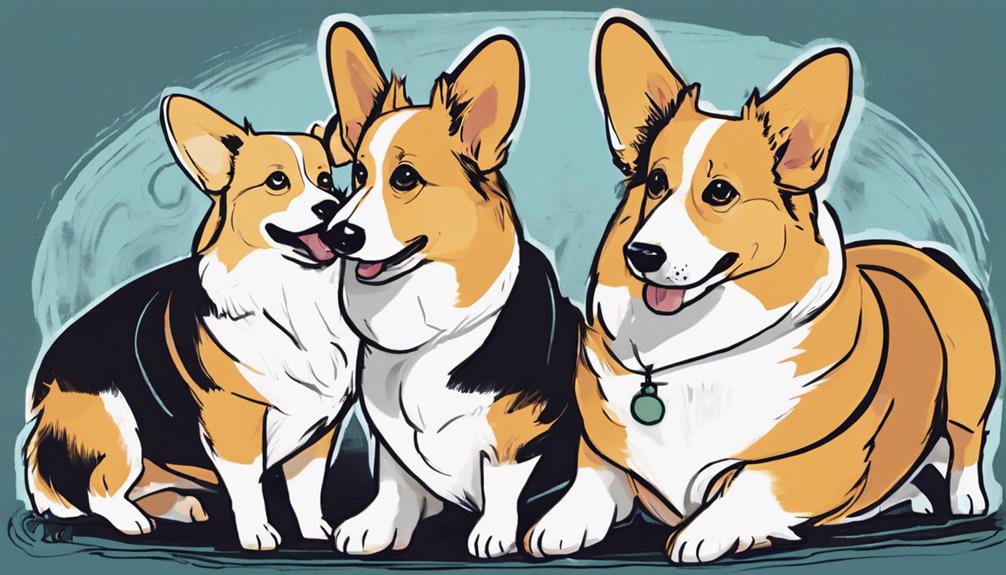
While both the Pembroke and Cardigan Corgis share a playful nature, their temperamental differences can significantly influence their suitability for various households and lifestyles.
The Pembroke Corgi typically exhibits higher playfulness levels, thriving in dynamic environments that encourage interactive play. This breed's social behavior leans towards being more extroverted, making them excellent companions for active families or individuals who enjoy outdoor activities.
In contrast, the Cardigan Corgi tends to display a more reserved demeanor. While still playful, their playfulness levels might manifest in calmer, more focused bursts of energy. This breed often forms strong attachments with their families and can be slightly more protective, which influences their social behavior. They may be less inclined to engage with unfamiliar people compared to Pembrokes, favoring a more cautious approach.
Choosing between these breeds comes down to understanding their distinct temperaments. If you're seeking a lively, sociable dog to keep up with an active lifestyle, the Pembroke may be your best bet. However, if you prefer a loyal, slightly more introverted companion, the Cardigan could be the right fit.
Lifespan and Health Issues
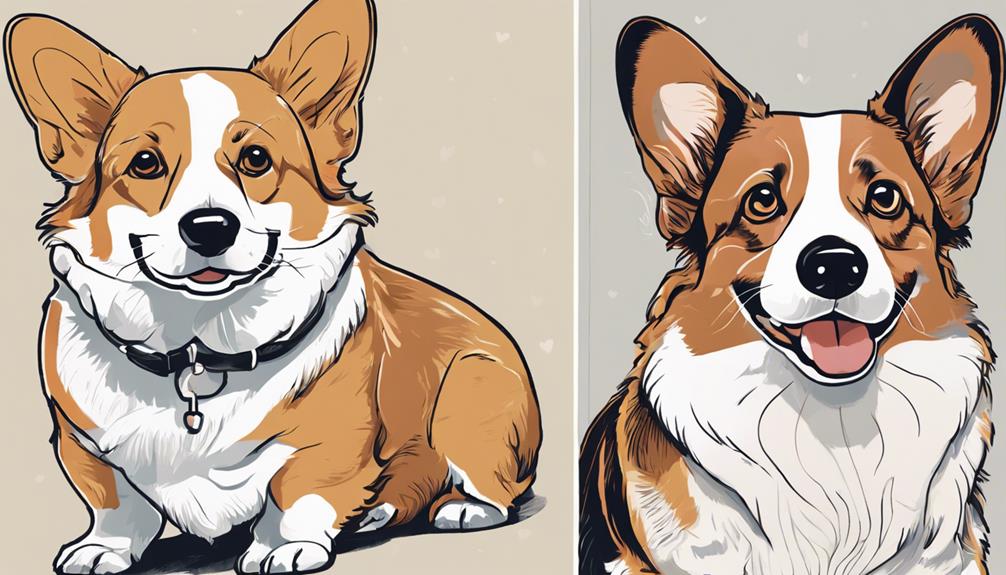
When considering Corgi breeds, you'll find notable differences in average lifespan and health issues.
Pembroke Welsh Corgis typically live around 12 to 15 years, while Cardigan Welsh Corgis may reach slightly longer lifespans.
However, both breeds are prone to specific health concerns, such as hip dysplasia and degenerative myelopathy, which can impact their quality of life.
Average Lifespan Comparison
Understanding the average lifespan of Corgi breeds requires examining their genetic predispositions to specific health issues, which significantly influence longevity.
The two primary Corgi breeds, the Pembroke Welsh Corgi and the Cardigan Welsh Corgi, exhibit notable lifespan differences, largely due to their unique genetic backgrounds. Generally, you can expect Pembrokes to live around 12-15 years, while Cardigans typically average 12-14 years.
Corgi longevity factors include breed-specific traits, such as susceptibility to hip dysplasia and degenerative myelopathy, which can vary between the breeds.
For instance, Pembrokes often face a higher risk of intervertebral disc disease, impacting their quality of life and lifespan. In contrast, Cardigans tend to exhibit a more balanced genetic profile, potentially leading to a longer, healthier life.
Common Health Concerns
Corgi breeds face several common health concerns that can directly impact their lifespan and overall quality of life, with specific issues varying between the Pembroke and Cardigan Welsh Corgis.
Both breeds are predisposed to obesity, which can exacerbate other health issues like hip dysplasia and degenerative myelopathy. Pembrokes often encounter eye problems, including cataracts and progressive retinal atrophy, while Cardigans may be more susceptible to heart conditions such as mitral valve disease.
To ensure the well-being of your Corgi, proactive health screening is essential. Regular veterinary check-ups can help detect potential issues early, allowing for timely intervention.
Genetic predispositions play a significant role in these health concerns, so consider choosing a breeder who conducts responsible health testing. This practice can minimize the chances of inheriting genetic disorders.
Exercise and Activity Needs
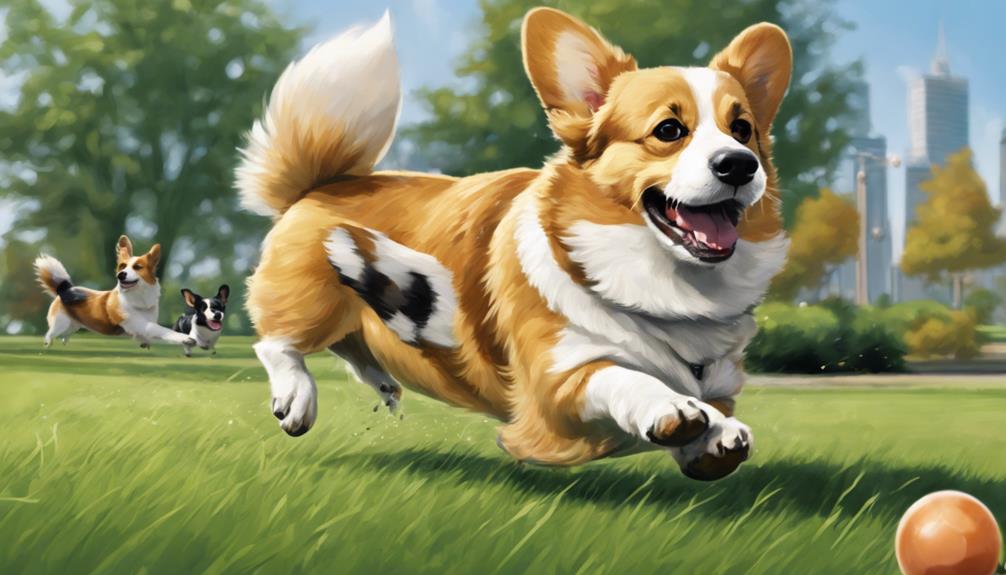
To maintain optimal health and prevent behavioral issues, both Pembroke and Cardigan Welsh Corgis require a structured exercise regimen that includes daily walks, playtime, and mental stimulation tailored to their unique energy levels and temperaments.
Corgis are active, intelligent dogs, and their exercise needs reflect this. For Pembrokes, about 60 minutes of varied activity daily is ideal, incorporating brisk walks and engaging games to channel their energy effectively. Cardigans, being slightly more reserved, may thrive on around 45-60 minutes but still need consistent engagement.
Both breeds benefit from interactive toys and agility exercises to stimulate their minds and bodies, addressing their inherent herding instincts. Without sufficient exercise, they can develop unwanted behaviors like excessive barking or destructive chewing, stemming from boredom or pent-up energy.
Incorporating structured routine and flexibility in activities is crucial. You might consider varying your routes or introducing new games to keep their interest piqued.
Ultimately, meeting their activity requirements not only ensures they remain physically fit but also fosters a balanced, happy disposition, allowing them to express their exuberant personalities freely.
Training and Socialization
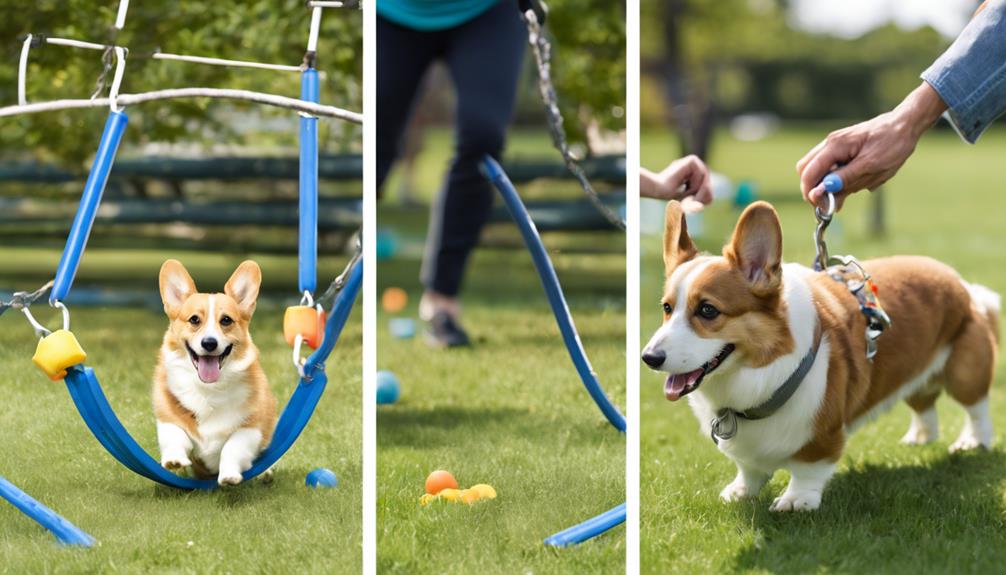
Regular exercise lays the groundwork for effective training and socialization, which are vital for shaping well-rounded Pembroke and Cardigan Welsh Corgis. Both breeds possess a strong herding instinct, making them intelligent yet independent. To harness this potential, you should begin with structured obedience training, focusing on commands like “sit,” “stay,” and “come.” Consistency is key, as Corgis thrive on routine and clear expectations.
Implementing socialization strategies is equally crucial. Expose your Corgi to various environments, people, and other animals from an early age. This exposure helps mitigate any fear or aggression, enhancing their adaptability. Use positive reinforcement techniques, rewarding desirable behaviors with treats or praise, which builds trust and encourages repeat performance.
Corgis respond well to training that respects their spirited nature. Incorporate play into your sessions, as it keeps them engaged while reinforcing skills. Group classes can also facilitate socialization with other dogs, fostering healthy interactions.
Choosing the Right Corgi

When selecting the right Corgi for your lifestyle, it's essential to consider the distinct characteristics and temperaments of both the Pembroke and Cardigan Welsh Corgi breeds.
The Pembroke, known for its outgoing nature and affinity for social interaction, may align with your desire for a playful companion. This breed thrives in active environments, making it suitable for those with dynamic Corgi lifestyle choices.
On the other hand, the Cardigan, characterized by its sturdier build and somewhat reserved demeanor, offers a loyal and protective disposition. If you value a more independent yet affectionate pet, the Cardigan might be your ideal match.
Assessing Corgi breed compatibility with your daily routine is crucial. Both breeds require regular exercise, but the Pembroke may demand more social engagement, while the Cardigan may be content with structured activities. Consider your living situation, family dynamics, and activity level.
Ultimately, understanding the nuanced differences between these breeds will guide you in making an informed decision that aligns with your lifestyle. Choose wisely, as the right Corgi can enhance your life with companionship, joy, and a sense of adventure.
Frequently Asked Questions
Are There Specific Dietary Needs for Different Corgi Breeds?
Yes, different corgi breeds can have specific dietary restrictions. You should consider tailored nutritional supplements, focusing on protein sources, calorie intake, and potential allergies to ensure optimal health and energy for your corgi's unique needs.
How Do I Identify a Purebred Corgi?
To identify a purebred Corgi, you'll need pedigree verification and must adhere to breed standards. Examine physical traits like size, coat, and temperament while consulting breed registries for authentic lineage documentation.
What Are the Common Behavioral Issues in Corgis?
Corgis often exhibit behavioral issues like separation anxiety, which stems from their strong attachment to you. Additionally, excessive barking can arise from boredom or frustration, necessitating consistent training and mental stimulation to mitigate these challenges effectively.
Can Corgis Adapt to Apartment Living?
Corgis can adapt to apartment living if you ensure they get sufficient exercise and socialization. Regular walks and playtime are essential for their mental and physical health, allowing them to thrive in smaller spaces.
Are Corgis Good With Children and Other Pets?
Corgis generally exhibit friendly temperaments and thrive through proper socialization. They often bond well with children and other pets, but early exposure and training are crucial to ensure harmonious interactions within a diverse household environment.
Conclusion
In conclusion, distinguishing between Pembroke and Cardigan Welsh Corgis hinges on their physical traits and temperamental nuances.
Recognizing the shorter stature and playful demeanor of Pembrokes versus the robust build and loyalty of Cardigans can guide your choice.
Understanding their unique exercise needs and socialization requirements further ensures you select a breed that complements your lifestyle.
By considering these factors, you'll find the ideal Corgi that aligns with your preferences and living situation.

